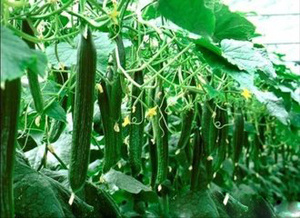Welcome to Jiangxi New Reyphon Biochemical Co., Ltd!
Service Hotline:0796-2676038 中文版 · ENGLISH
Development of S-inducible in China
Release time:
2020-05-20
S-inducer(Abscisic acid, S-ABA) Like vaccines, it can activate the resistance or adaptation mechanism of animals and plants to adversity, improve the ability of plants to resist drought, cold and disease, maintain the growth ability of crops under abnormal climate, soil and environmental conditions, and obtain a good harvest. It, along with auxin, ethephon, gibberellin and cytokinin, are listed as the five major natural growth regulators of plants, and are internationally recognized as biological pesticides for plants to resist "adversity" disasters.
S-lure has been widely used in agricultural production abroad, especially in the United States, Japan, Southeast Asia and other places, and has gradually been widely promoted in agricultural production in China. In order to let farmers have a better understanding of S-inducer, the author interviewed Professor George Walkerton, an authoritative expert in the field of S-inducer who has been committed to the research, development and promotion of plant regulators for many years.
In the United States, S-inducer has become a necessary agent for the production of high quality grapes; the use of S-inducer in the United States can achieve high quality results. At present, the application of S-inducer in the United States is mainly reflected in four aspects:
First, the new shoots are sprout and the flowering period is the same, and the full flowering period is about 10 days ahead of schedule. The method of application is to use 1~2 ppmS-inducer solution for root irrigation from the water absorption stage to the initial germination stage. It should be noted that in the water absorption period to the early stage of germination, because the bud has not yet detached, so the spray treatment has no effect.
The second is to enhance the early expansion of the grapes with the core. The method of application was to spray the whole plant with 20 ppm S-inducer solution twice or root-filling with 1-2 ppm S-inducer solution 10-15 days before the beginning of flowering and at the end of flowering, respectively.
The third is to reduce the hardening of fruit stalks in seedless cultivation, promote hypertrophy of fruit grains, reduce fruit cracking, reduce grain loss, and promote early maturity of coloring. The method of use is to add 25 ppm S-attractant solution to the gibberellin regular treatment solution.
Four is to improve the summer high temperature period of poor coloring and high temperature barriers, once again to promote fruit hypertrophy, so that the harvest period 1 to 2 weeks earlier, improve fruit quality and taste. The use method is that when about 1/3 of the fruit room in the garden starts to color, 1~2 ppmS-attractant solution is used for root irrigation treatment or special sprayer to prevent fruit powder contamination is used for fruit spraying treatment. Whether there is a bag or no bag, root irrigation treatment does not affect its effect, and there is no need to worry about the fruit surface being contaminated. It should be noted that when spraying fruit, the promotion of coloring is faster, but the improvement of taste is slow. Therefore, the standard of harvest should not only be marked by color, but also be harvested after confirming sugar content at the same time. Quality decline, adverse preservation and other negative effects.
In 2002, Tianjiao International Group of the United States invested in the introduction of technological achievements in the production of S-attractant by fungal liquid submerged fermentation, and established Tianjiao International Group (China) Co., Ltd. After years of efforts, it has successfully developed a series of products suitable for China's soil conditions, such as "more crops" and "Nuobifeng.

With the continuous expansion of the planting area of table grapes in China in recent years, and the consumption level of Chinese residents has increased year by year, domestic growers, distributors, and consumers are now paying more attention to the safety, quality and taste of grapes. The function of S-inducer in the process of grape planting makes it a reality to produce green and safe grapes with excellent fruit shape and color and pure taste.
At present, the application of S-inducer produced by Tianjiao International Group in grapes has been applied and verified in many provinces in China, and the feedback effect is very ideal. And through many years of verification, "more crops" is more in line with Chinese grape cultivation habits and medication habits.
In the United States, high quality fruits can be produced by using S-inducer with reasonable collocation and correct cultivation techniques, but there are still some differences between the cultivation conditions in China and the United States. First of all, the soil conditions and climatic conditions in China are different from those in the United States. Therefore, when promoting the application technology of S-attractant in China, more consideration should be given to the actual situation in China for adjustment, and do not apply mechanically. Fortunately, Tianjiao International Group Co., Ltd. has been committed to the exploration and verification of the application of S-attractant in Chinese grapes for many years, and has now summed up a set of drug regimens suitable for the current situation of grape cultivation in China.
For example, when "more crops" irrigation is used on fresh grapes, it is applied once each 10-15 days before flowering, after fruit thinning and at the beginning of coloring (bagging is not affected). The concentration of the drug is 1000 times diluted (20 grams of more crops per 1000 liters of water), and the irrigation amount per plant = 1000 liters of water per plant. Can play a fruit coloring uniform, sweetness increase, early listing, listing the role of preservation.
Crop harvest is applied during the color change period of table grapes (when 10% of fruit grains are colored). The concentration of the drug is 250-500 times diluted by spraying and soaking the fruit, which can promote coloring, early listing, reduce acidity, increase sugar content, improve anthocyanin content and fruit quality, and be resistant to storage and transportation. At the same time, it can effectively avoid the negative effects of fruit drop, tree damage, fruit softening, quality decline, adverse preservation and so on.
Related news
Jiangxi Xinruifeng Biochemical Co., Ltd.
Address: In Salt Chemical Industry City, Xingan County, Ji'an City
Jiangxi Province
Contact number:0086-0796-2676028
RM:Chen Hongxia (Amy)
E-mail:wantyan@reyphon.com
Tel: 18172879783

No public

Douyin

Kuaishou




